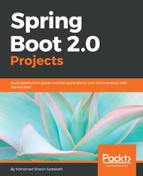Congratulations on completing this chapter, where the skills and knowledge required to build microservices were discussed in detail. This chapter started off by explaining what a microservices architecture is and how it is beneficial both in terms of development and maintenance. It talked about the requirements of the microservice architecture being developed and used a UML use case diagram to explain the requirement visually.
This chapter also talked about how to understand the domain model of an application based on the requirements (Saber) and use Spring Data Redis to convert those domain model entities into Redis maps. A UML class diagram was used to explain the domain model in detail. Next, it explained how to write data repositories for those entities using Spring Data Redis with minimum effort for commonly used CRUD operations. It also explained how to write custom query methods in data repositories. Also, it explained how to encapsulate business logic inside Spring Service components. It also talked about how to use Spring WebFlux REST controllers to provide coordination of different services.
Furthermore, it talked about the Docker container platform, explaining what a container is before diving into creating and deploying Spring Boot 2.0 applications as Docker images. Finally, this chapter showed how to use Docker Compose to create complex systems using Docker containers. The chapter also demonstrated the usage of Saber in detail. We'll learn more about application development in coming chapters.
